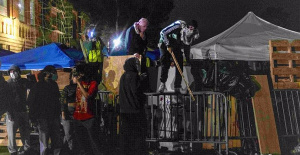The Air Force has already carried out a dozen sorties to intercept Russian flights that did not comply with flight regulations
SIAULIAI (LITHUANIA), 23 May. (From the special envoy of EUROPA PRESS, Pilar de la Cuesta) -
Defense Minister Margarita Robles praised this Monday the "peace mission" of the Spanish Armed Forces on NATO's eastern border with Russia. And, specifically, the work of the Lithuanian Air Force monitoring the Baltic sky against the intrusion of Russian planes that approach its airspace without complying with international flight regulations.
Lithuania shares a border with Belarus and with the Russian enclave of Kaliningrad and the traffic of Russian planes through its territory is constant. Most of them fly identified and comply with international criteria, but when they do not, it is the mission of the Spanish 'fighters' to go out to meet them to dissuade them from entering their airspace.
Specifically, the Air Force has already carried out a dozen real missions --'Alpha Scramble'-- of interception. All of them carried out by between one and four Russian aircraft, as detailed by Lieutenant Colonel David Soto, in command of the Spanish mission.
The last of the outings took place this Monday shortly before the arrival of the minister. These Russian 'surprises' are now common during official visits. It happened during a trip by Robles to a similar air police mission in Bulgaria last February and also at the same base in Lithuania last summer during a visit by the Prime Minister, Pedro Sánchez, who even had to interrupt a conference press with his Lithuanian counterpart to allow the departure of the Spanish bombers.
At the Siauliai base there are 140 Air Force troops deployed with eight F-18 aircraft, the largest Spanish deployment since its participation in similar aerial police missions. Six of the aircraft are transferred to NATO command and the other two guarantee maintenance.
Spain, in command of the operation, shares a mission with the Czech Republic, which provides five Gripen fighters. And it also carries out joint exercises with the French and Belgian air forces deployed at the Amari base in Estonia.
Since the deployment began on April 1, the Spanish aircraft have made more than 200 sorties and exceeded 380 flight hours. Only twelve of them have been to intercept unidentified aircraft and the rest have consisted of deterrence operations on the border, exercises or integration missions.
When the Spanish 'fighters' intercept Russian flights, many of them respond in a friendly way, explained Lieutenant Colonel Soto. Others, however, carry out provocative maneuvers, although without ever being aggressive, he has pointed out.
Robles thanked the "effort" of the Armed Forces inside and outside of Spain, especially in the current context of the invasion of Ukraine. "It is a peace mission, the Armed Forces always work for and for peace", the minister stressed.
In this sense, he has insisted that Spain is a "serious and reliable" ally for its international allies and its military is "at the forefront" and "committed". "Your effectiveness and efficiency is prestige for the Armed Forces and helps high-level relations," shared the Chief of Defense Staff (Jemad), Admiral General Teodoro López Calderón.
Air policing missions have been carried out since 2004, when Estonia, Latvia and Lithuania, without an Air Force with sufficient surveillance and defense capacity of their own, joined NATO. This work was reinforced in 2014 after the invasion of the Crimean peninsula, when the Alliance decided to also reinforce the southern zone (Romania and Bulgaria).
The mission of the 'allied' aircraft in these operations is dissuasive through the interception and identification of any aircraft that flies over their airspace without being identified or without having presented a flight plan.
3

 Exploring Cardano: Inner Workings and Advantages of this Cryptocurrency
Exploring Cardano: Inner Workings and Advantages of this Cryptocurrency Seville.- Economy.- Innova.- STSA inaugurates its new painting and sealing hangar in San Pablo, for 18 million
Seville.- Economy.- Innova.- STSA inaugurates its new painting and sealing hangar in San Pablo, for 18 million Innova.- More than 300 volunteers join the Andalucía Compromiso Digital network in one month to facilitate access to ICT
Innova.- More than 300 volunteers join the Andalucía Compromiso Digital network in one month to facilitate access to ICT Innova.-AMP.- Ayesa acquires 51% of Sadiel, which will create new technological engineering products and expand markets
Innova.-AMP.- Ayesa acquires 51% of Sadiel, which will create new technological engineering products and expand markets A Spanish guide dies in an attack in Ethiopia
A Spanish guide dies in an attack in Ethiopia Feijóo sees in the clash with Milei another attempt to "polarize" and disgraces Sánchez for continuing without explaining his wife's work
Feijóo sees in the clash with Milei another attempt to "polarize" and disgraces Sánchez for continuing without explaining his wife's work STATEMENT: Campari organizes an unforgettable launch party at the Cannes Film Festival (1)
STATEMENT: Campari organizes an unforgettable launch party at the Cannes Film Festival (1) STATEMENT: Campari organizes an unforgettable launch party at the Cannes Film Festival (2)
STATEMENT: Campari organizes an unforgettable launch party at the Cannes Film Festival (2) How Blockchain in being used to shape the future
How Blockchain in being used to shape the future Not just BTC and ETH: Here Are Some More Interesting Coins Worth Focusing on
Not just BTC and ETH: Here Are Some More Interesting Coins Worth Focusing on 'Fallero hologram: the art of the bow', the UPV and Telefónica pioneer the use of VR technology applied to training
'Fallero hologram: the art of the bow', the UPV and Telefónica pioneer the use of VR technology applied to training UA researchers develop a device to desalt food products through electrodialysis
UA researchers develop a device to desalt food products through electrodialysis The UA participates in the proposed Ramses mission to study the close passage of an asteroid to Earth
The UA participates in the proposed Ramses mission to study the close passage of an asteroid to Earth They develop a tool to end discrimination biases in AI
They develop a tool to end discrimination biases in AI A million people demonstrate in France against Macron's pension reform
A million people demonstrate in France against Macron's pension reform Russia launches several missiles against "critical infrastructure" in the city of Zaporizhia
Russia launches several missiles against "critical infrastructure" in the city of Zaporizhia A "procession" remembers the dead of the Calabria shipwreck as bodies continue to wash up on the shore
A "procession" remembers the dead of the Calabria shipwreck as bodies continue to wash up on the shore Prison sentences handed down for three prominent Hong Kong pro-democracy activists
Prison sentences handed down for three prominent Hong Kong pro-democracy activists ETH continues to leave trading platforms, Ethereum balance on exchanges lowest in 3 years
ETH continues to leave trading platforms, Ethereum balance on exchanges lowest in 3 years Investors invest $450 million in Consensys, Ethereum incubator now valued at $7 billion
Investors invest $450 million in Consensys, Ethereum incubator now valued at $7 billion Alchemy Integrates Ethereum L2 Product Starknet to Enhance Web3 Scalability at a Price 100x Lower Than L1 Fees
Alchemy Integrates Ethereum L2 Product Starknet to Enhance Web3 Scalability at a Price 100x Lower Than L1 Fees Mining Report: Bitcoin's Electricity Consumption Declines by 25% in Q1 2022
Mining Report: Bitcoin's Electricity Consumption Declines by 25% in Q1 2022 Oil-to-Bitcoin Mining Firm Crusoe Energy Systems Raised $505 Million
Oil-to-Bitcoin Mining Firm Crusoe Energy Systems Raised $505 Million Microbt reveals the latest Bitcoin mining rigs -- Machines produce up to 126 TH/s with custom 5nm chip design
Microbt reveals the latest Bitcoin mining rigs -- Machines produce up to 126 TH/s with custom 5nm chip design Bitcoin's Mining Difficulty Hits a Lifetime High, With More Than 90% of BTC Supply Issued
Bitcoin's Mining Difficulty Hits a Lifetime High, With More Than 90% of BTC Supply Issued The Biggest Movers are Near, EOS, and RUNE during Friday's Selloff
The Biggest Movers are Near, EOS, and RUNE during Friday's Selloff Global Markets Spooked by a Hawkish Fed and Covid, Stocks and Crypto Gain After Musk Buys Twitter
Global Markets Spooked by a Hawkish Fed and Covid, Stocks and Crypto Gain After Musk Buys Twitter Bitso to offset carbon emissions from the Trading Platform's ERC20, ETH, and BTC Transactions
Bitso to offset carbon emissions from the Trading Platform's ERC20, ETH, and BTC Transactions Draftkings Announces 2022 College Hoops NFT Selection for March Madness
Draftkings Announces 2022 College Hoops NFT Selection for March Madness



























